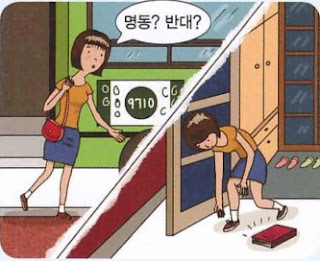
-느다는 것이/ 다는 것이 is used to indicate that the result stated in the following clause is not the result of the intention stated in the preceding clause. It is also used in the shortened form -(느)ㄴ다는 게. It only attaches to verbs.
가: 왜 이렇게 늦었어요?
Why are you so late?
나: 미안해요. 명동으로 가는 버스를 탄다는 것이 반대쪽으로 가는 버스를 타서 갈아타고 오느라고 늦었어요.
I’m sorry. I thought I was getting on the bus to Myeongdong, but I got on one going in the opposite direction and became late because I had to change buses.
가: 부탁한 책은 가지고 왔어요?
Did you bring the book I asked about?
나: 어머, 들고 나온다는 것이 현관 앞에 놓고 그냥 나왔네. 미안해요. 어떡하지요?
Oh, dear, I placed it at the front entrance and thought that I’d take it with me, but I ended up just leaving it. I’m sorry. What should I do?
가: 이 앞 사거리에 경찰차가 서 있던데 무슨 일 있었어요?
There was a police car parked at the intersection just over there. What happened?
나: 초보 운전자가 정지선에서 브레이크를 밟는다는 게 액셀을 밟았대요. 다행히 주변에 아무도 없어서 큰 사고는 없었대요.
Apparently, an inexperienced driver mistakenly hit the gas pedal at the stop line instead of the brake. Luckily, there was no one else around, so it wasn’t a big accident.
가: 피곤해 보이는데 잠을 잘 못 잤어요?
You look tired. Did you not sleep well?
나: 어제 리포트를 쓰다가 저장 버튼을 누른다는 게 삭제 버튼을 눌러서 저녁 내내 작업한 내용이 다 없어져 버렸거든요. 그래서 다시 쓰느라 밤을 새웠어요.
Yesterday, I was writing a report and inadvertently hit the delete button instead of the save button, so I lost all of the work I had done during the entire evening. So I stayed up all night trying to rewrite everything.
가: 도와 드린다는 것이 오히려 폐만 끼친 것 같아서 죄송하네요.
It seems my assistance is actually more of a hindrance, so I’m sorry.
나: 아니에요. 도음이 많이 된걸요.
Not at all. You’ve really helped a lot.
For this expression, the subjects of both the preceding and following clauses must be the same.
(제가) 구경만 한다는 것이 하나밖에 안 남았다고 하니까 친구가 또 사고 말았어요. (X)
-> (제가) 구경만 한다는 것이 하나밖에 안 남았다고 하니까 (제가) 또 사고 말았어요. (〇)
-> 친구가 구경만 한다는 것이 하나밖에 안 남았다고 하니까 (친구가) 또 사고 말았다고 해요. (〇)
>> You can click on the title of each grammar below to see other grammar which also expresses ‘Intention’
>> Full of ‘Korean grammar in use – Advanced’: Click here
>> Follow my page to get Korean lessons: Say Hi Korean
